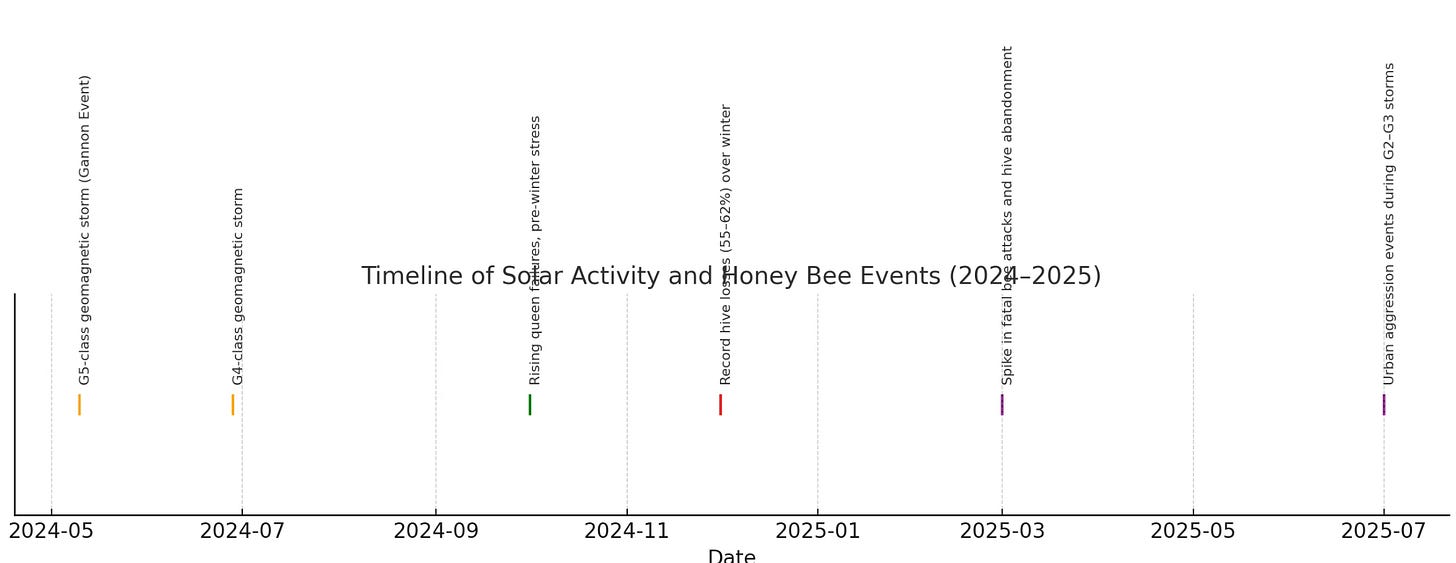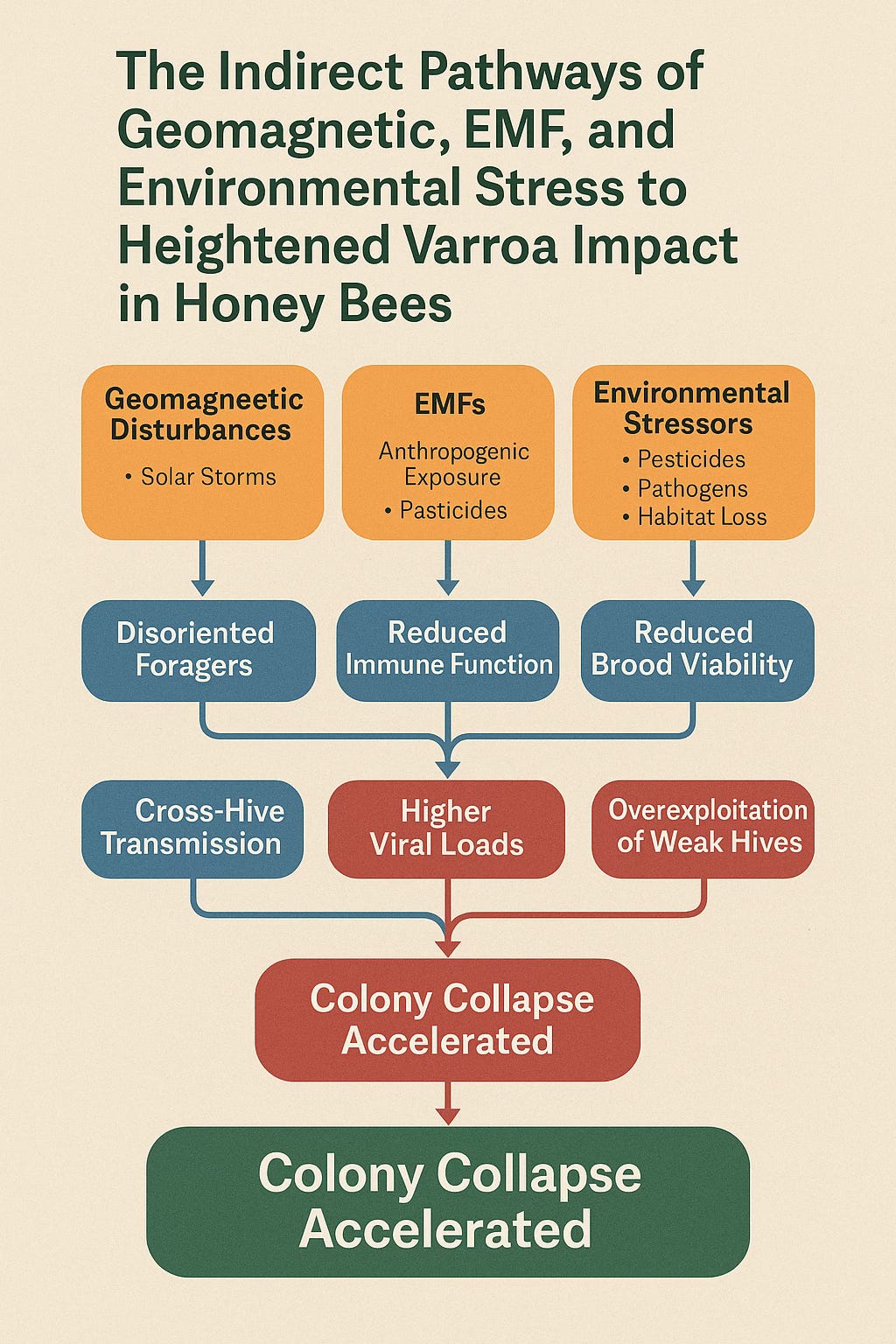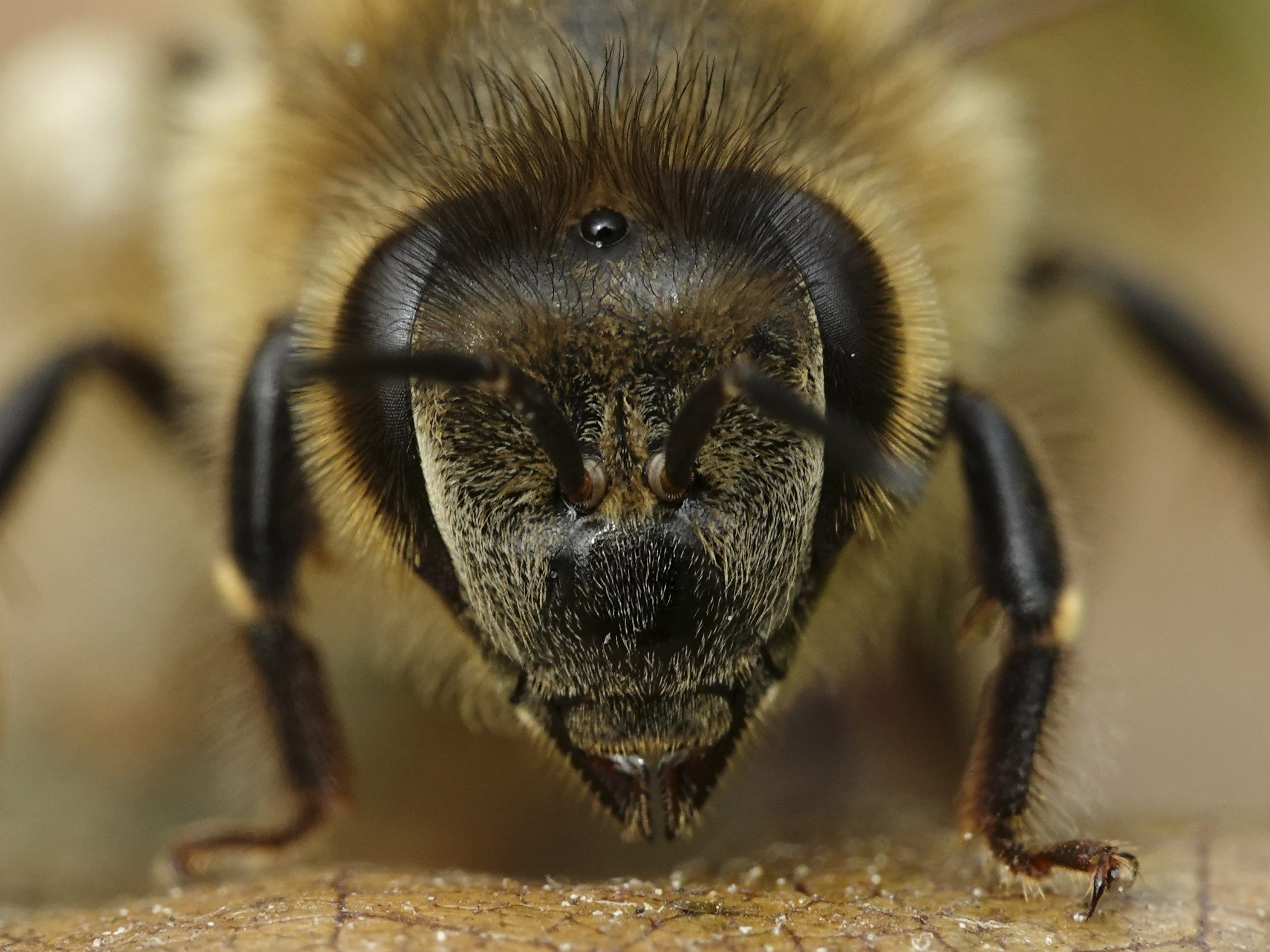How Geomagnetic Disturbances May Be Driving Bees to Panic, Vanish, and Attack
Yanasa TV News
Magnetospheric Disruption and Environmental Stress as Drivers of Elevated Honey Bee Aggression and Colony Collapse in 2024–2025
Recent data from 2024–2025 reveal a sharp and deeply concerning rise in honey bee (Apis mellifera) aggression alongside record-breaking winter colony losses. While well-known biological stressors—Varroa mites, neonicotinoid pesticides, and habitat degradation—have long been studied as contributors to Colony Collapse Disorder (CCD), emerging trends suggest a more complex, system-level cause is at play.
This report proposes a novel integrative hypothesis: that intensified geomagnetic disturbances from Solar Cycle 25 (SC25), amplified by anthropogenic electromagnetic field (EMF) pollution and compounded ecological stress, are disrupting honey bee magnetoreception. This interference impairs spatial orientation, alters behavior, and leads to hive breakdown and collapse. Furthermore, a forecasted Grand Solar Minimum (GSM) during the upcoming Solar Cycle 26 (SC26) may exacerbate this disruption by chronically destabilizing Earth’s electromagnetic environment.
By synthesizing solar-geophysical trends with behavioral and physiological data, we propose a magnetobiological framework to better explain the alarming increase in honey bee collapse and aggression in the modern era.

A New Phase of Pollinator Collapse
Honey bees are indispensable to global agriculture and ecosystem balance. Yet the hive losses and behavioral anomalies of 2024–2025—far exceeding historical norms—signal a disturbing shift. Traditional theories that attribute CCD to pathogens, pesticides, or malnutrition fail to explain the sudden surges in bee aggression, disoriented foragers, and mass abandonment seen during this period.
Instead, this report introduces a systems-level interpretation: that electromagnetic instability, driven by natural solar variability and exacerbated by human infrastructure, may be the primary environmental destabilizer. In this view, magnetospheric disturbance is not a peripheral stressor but a central trigger in modern bee collapse.
Timeline of Key Events (2024–2025)
- May 10–13, 2024: The Gannon Storm (G5-rated) produces the most severe geomagnetic storm in over two decades.
- June & October 2024: Additional G4-level storms recorded, coinciding with hive losses and abnormal behavior reports.
- June 2025: Multiple G2–G3 geomagnetic events precede violent bee attacks in France (July 6) and California (July 24), raising public alarm.

Abnormal Bee Behavior & Attack Incidents (2025)
Aurillac, France (July 2025)
- A rare, sustained bee attack left 24 people injured, including three critically injured. Local authorities removed the hive after concern over Asian hornetspotentially triggering abhorrent hive aggression. https://timesofindia.indiatimes.com/world/europe/bee-attack-in-france-24-injured-in-aurillac-hive-removed-after-asian-hornet-threat/articleshow/122310474.cms
Bee attack kills worker in Scottsdale (July 2025)
- Officers said 65-year-old Nicolas Lopez Soto and another worker were using a lift to remove stucco from a side column near the roof area when a swarm of bees attacked at the Vi at Silverstone Independent Living Facility, near Scottsdale and Pinnacle Peak roads, around 9:30 a.m. https://www.azfamily.com/2025/07/09/bee-attack-kills-worker-day-before-planned-bee-hive-removal-scottsdale/?outputType=amp
Comanche, Texas (May 9, 2025)
- Africanized bees allegedly attacked ranch horses and owners; three beloved rodeo horses were killed, and the owners sustained numerous stings. Characterized by “pure panic” and high aggression.
https://www.chron.com/news/science-environment/article/bee-attack-horses-texas-ranch-20327514.php
April 27, 2025 – Eastland/Friendship Park, Texas (USA)
- Stephen Daniel, mowing near an abandoned structure, disturbed a hive and was swarmed. He drove off in panic, crashed, and later died due to circulatory collapse from multiple stings. The hive likely comprised Africanized bees. https://nypost.com/2025/05/18/us-news/man-dies-in-bee-attack-despite-frantic-escape-attempt-that-had-him-drive-through-neighbors-yard/
June 5, 2025 – Ujjain, Madhya Pradesh (India)
- A sudden swarm attacked police officers resting near tree-located hives at the police training center. A 60‑year‑old inspector died, and at least three officers were seriously injured. https://people.com/random-bee-attack-injures-24-people-3-critically-france-11767457
July 24, 2025 – Santee, California (USA)
- Approximately 100 bees attacked a grandmother outdoors. She suffered anaphylaxis and required hospitalization. A passing local plumber intervened, was stung himself, and helped rescue her. First responders later released bee safety guidelines. https://people.com/plumber-steps-in-to-stop-swarm-of-bees-attacking-grandmother-11779599
July 29, 2025 – Houston, Texas (USA)
- A large open-air hive discovered near Daikin Park before a baseball game. Several bystanders were stung and the hive was identified as a public hazard; scheduled for live relocation. https://www.chron.com/life/wildlife/article/daikin-park-bee-hive-astros-20790376.php
July 10, 2025 – Barbour County, Alabama (USA)
- Feral swarm of ‘killer bees’ euthanized in Alabama. Officials trapped and humanely euthanized an Africanized honey bee swarm in rural Alabama. Surveillance traps set in a 5-mile radius to monitor for further activity. Highlights regional spread of AHB to at least 13 states. https://www.wvtm13.com/article/alabama-killer-bees-traps-barbour-county/65256254
Thangool, Australia (early 2025)
- A man in his 70s stung dozens of times suffered an anaphylactic reaction while working outdoors, requiring aerial medevac to a hospital.
Courier Mail
Hive Die-Offs & Colony Collapse Events
U.S. Nationwide (June 2024–Mar 2025)
- Commercial beekeepers reported an average 62% colony loss, totaling ~1.6 million lost colonies, the largest die-off in U.S. history. Losses estimated to cost over $600 million. https://www.canr.msu.edu/news/reports-of-high-honey-bee-colony-losses-and-how-farmers-and-growers-can-support-honey-bees
- Veteran beekeeper Steve Ellis experienced nearly 70% colony loss at his operation. Many hives were found silent or empty despite healthy brood frames.
https://www.mprnews.org/story/2025/07/21/minnesotan-mission-save-honeybees-shrink-pesticide-use - Universities, USDA, and Project Apis m. coordinated investigation into widespread hive failures and soaring losses across multiple states. https://www.theguardian.com/us-news/2025/mar/25/honeybees-deaths-record-high
Behavioral Anomalies in Hives
Increased, Unseasonal Aggression
- Sudden defensive swarming in urban and residential areas was reported out of typical season and at unusually high intensity.
Hive Abandonment & Silent Collapse
- Beekeepers found hives with nearly empty adult populations while brood frames remained intact. Many hives collapsed overnight without warning.
Magnetoreception in Honey Bees
Honey bees possess magnetite-based magnetoreceptors used for orientation, comb alignment, spatial memory, and geolocation during foraging. These receptors are acutely sensitive to geomagnetic fluctuations.
Key findings:
- Frier et al. (2009): Magnetic disturbances led to failed homing behavior in honey bees.
- Magnets, magnetic field fluctuations and geomagnetic disturbances impair the homing ability of honey bees (Apis mellifera) https://www.tandfonline.com/doi/pdf/10.3896/IBRA.1.53.4.15
- Schmal et al. (2015): Identified a near-perfect correlation (R² = 0.97) between high geomagnetic activity (K-index ≥5) and mass forager disappearance—classic symptoms of CCD.
In 2024–2025, repeated solar storms disrupted Earth’s magnetosphere, disturbing bees’ internal navigational systems. Colonies experienced sudden forager losses and disoriented return flights, while residual hive stress manifested as heightened aggression and defensive behavior.
The 2024–2025 Solar Surge
Solar Cycle 25 reached its projected maximum in mid-2025, bringing an uptick in solar flares, coronal mass ejections (CMEs), and geomagnetic storms. These events intensified magnetospheric turbulence and coincided with increased reports of queen failure, hive abandonment, and urban aggression incidents.
- The Gannon Storm (May 2024) reached G5 intensity and triggered global magnetic field fluctuations.
- Subsequent G4-level storms (June, October 2024) produced visible auroras and coincided with spikes in hive collapse reports.
- June–July 2025: G2–G3 storms preceded violent bee attacks and colony disappearance events.
Even moderate disturbances appeared to impact bee behavior—suggesting a heightened sensitivity due to compounding stress factors.
Magnetic Disorder and Electromagnetic Pollution
Human infrastructure now bathes bees in anthropogenic EMFs—from high-voltage power lines to 5G transmitters and mobile towers. Research shows this electromagnetic smog acts as a chronic environmental stressor:
- EMFs disrupt queen reproduction, reduce brood viability, and lower colony survival rates.
- Exposure to fluctuating magnetic fields impairs foraging efficiency, learning capacity, and induces heightened aggression.
Schmal et al. (2015): Severe geomagnetic storms are statistically linked with mass bee losses.
Ferrer et al. (2019): ELF-EMF exposure increased bee aggression by 60% in controlled hive settings.
The interaction between natural geomagnetic disturbances and artificial EMFs appears to create a behavioral amplifiereffect—triggering extreme defensiveness, confusion, and ultimately collapse.
Compounding Stressors: A Threshold Model
Bee health is already under siege from:
- Biological agents: Varroa mites, pathogens, and viruses weaken immune and reproductive systems.
- Chemical toxins: Pesticides like neonicotinoids impair navigation, cognition, and detox pathways.
- Climate instability: Droughts, heatwaves, and floral dearth reduce forager efficiency and hive nutrition.
According to nonlinear ecological stress models (Scheffer et al., 2023), these compounding effects can push colonies past critical tipping points, where even moderate additional stress (e.g., a solar storm) leads to catastrophic collapse. The 2024–2025 pattern suggests that many colonies passed this threshold, shifting into a defensive, hyper-reactive survival mode.
The Solar Cycle 26 Warning
While SC25 produced acute electromagnetic disruptions, SC26 may usher in a more insidious threat:
- Forecasts suggest SC26 may be delayed, weak, or collapse entirely—indicators of a Grand Solar Minimum (GSM).
- During GSMs (e.g., Maunder, Dalton), solar wind pressure drops, Earth’s magnetosphere weakens, and cosmic ray flux increases.
- Such long-term magnetic drift may confuse or degrade magnetoreception over months or years—not just during acute storms.
For bees, already surrounded by manmade EMFs, this could lead to chronic orientation loss, higher winter die-offs, and long-term pollination collapse.
Historical and Natural Evidence
- Eclipses: Total solar eclipses (1999, 2004 India) caused clustering, silence, and delayed return flights in bees—suggesting magnetic and visual disruption.
- Historical minima: Bee mortality and migration anomalies during the Maunder and Dalton Minima parallel today’s concerns.
How Magnetospheric Disruption and Environmental Stress Could Indirectly Increase Varroa Infestations
While Varroa mites (Varroa destructor) are widely blamed as a primary cause of honey bee colony collapse, they may also be a secondary opportunist—their populations and damage levels may actually increase as a downstream effect of environmental, geomagnetic, and EMF-related stressors.
1. Disoriented Foragers Bring Mites Back
Geomagnetic disruption impairs bee navigation and foraging behavior. Disoriented foragers:
- Take longer to return to the hive (if at all)
- Are more likely to encounter parasitized bees from other colonies
- May drift into infected hives and pick up mites (a known vector pathway)
Result: Cross-contamination between hives increases, amplifying horizontal Varroa transmission.
2. Weakened Immune Systems Enable Mite Proliferation
Electromagnetic field (EMF) exposure, in combination with solar-induced geomagnetic disturbance, is known to:
- Disrupt melatonin and circadian rhythms in bees
- Cause oxidative stress and impair detoxification
- Reduce expression of immune-related genes (based on transcriptomic studies)
Result: Bees are less capable of grooming mites off themselves and are more vulnerable to mite-borne viruses like Deformed Wing Virus (DWV).
3. Reduced Brood Viability and Queen Performance
EMF and magnetoreception stress is shown to:
- Impair queen fertility and lifespan
- Lead to irregular brood patterns and lower larval survival
- Delay the replacement of failing queens
Result: A longer brood-rearing cycle or unbalanced brood demographics can favor Varroa reproductive cycles, which are tightly synced with capped brood cells.
4. Colony Instability Creates Mite Havens
Chaotic or collapsing hives (due to disorientation or aggression) lead to:
- More frequent absconding (abandonment of hives)
- Reduced hygienic behavior (critical for mite control)
- Queenlessness or requeening stress, which temporarily halts egg-laying and confuses colony structure
Result: Varroa mites exploit weakened, disorganized colonies, where they can reproduce unchecked.
5. Chemical-EMF Synergy Worsens Vulnerability
Studies show that bees exposed to EMFs become more sensitive to pesticides and fungicides, which can:
- Further reduce immunity
- Impair grooming behavior
- Shorten lifespan
Result: Sublethal chemical exposures—already problematic—become more damaging under geomagnetic stress, giving mites an even greater reproductive advantage.
While Varroa mites are often seen as the cause of collapse, they may actually be a biological indicator of a hive pushed beyond its stress threshold. In the 2024–2025 context, geomagnetic instability, EMFs, and ecological stress are likely weakening bees’ natural defenses—making them more vulnerable to a parasite they would otherwise resist.

Recognizing the Pattern
When overlaid, the timing of solar events and observed bee behavior reveals a striking synchronicity:
- Hive abandonment and aggression frequently follow geomagnetic storms.
- Urban hotspots of bee attacks correlate with high-EMF infrastructure and periods of elevated solar flux.
These are not random coincidences. They suggest the urgent need to adopt an electromagnetic systems theory of pollinator collapse.
Toward a Magnetobiological Framework
The extraordinary hive losses and behavioral extremes of 2024–2025 cannot be fully explained by mites or chemicals alone. The evidence increasingly points to a deeper environmental signal—geomagnetic instability—interacting with anthropogenic EMF pollution and other stressors to drive collapse.
As Solar Cycle 25 wanes and Solar Cycle 26 approaches, it is no longer sufficient to protect bees only from pesticides and pathogens. We must now consider the invisible forces that shape their existence—Earth’s magnetic field, solar cycles, and the human-made EMFs they were never evolved to endure.









